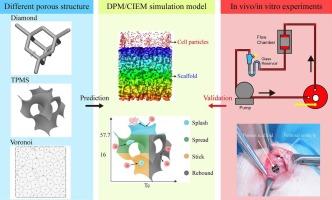Energy-based multiphase CFD framework integrating DPM and CIEM for predicting dynamic cell adhesion in porous scaffolds
IF 7.9
2区 材料科学
Q1 MATERIALS SCIENCE, MULTIDISCIPLINARY
引用次数: 0
Abstract
The architecture of porous scaffolds significantly influences the adhesion of seeded cells, which determines the scaffold’s final performance. However, how scaffold structure affects this process remains poorly understood. In this study, we aimed to address this challenge from the perspective of the hydromechanical microenvironment. We employed Computational Fluid Dynamics (CFD) method to simulate dynamic cell seeding in porous scaffolds with varying structures, using the Discrete Phase Model (DPM) to model seeded cells. A novel Cell Impingement Energy Model (CIEM) was implemented to capture cell-scaffold interactions, where adhesion was determined by impingement energy. The simulation results were validated through in vitro dynamic seeding and in vivo animal experiments. The results showed that despite comparable morphological parameters, TPMS and Voronoi scaffolds presented lower overall cell adhesion but a more uniform spatial distribution, while Diamond scaffolds exhibited higher cell adhesion, primarily localized on the surface. Adjusting the morphological parameters can improve the uniformity of cell distribution in Diamond scaffold. More importantly, the computational and experimental results were highly consistent, suggesting that CFD combining DPM and CIEM can effectively simulate dynamic cell seeding. This study presents a reliable approach for predicting cell adhesion in porous scaffolds, offering valuable insights for scaffold design and optimization.

基于能量的多相CFD框架集成DPM和CIEM预测多孔支架中细胞的动态粘附
多孔支架的结构显著影响种子细胞的粘附性,从而决定了支架的最终性能。然而,支架结构如何影响这一过程仍然知之甚少。在本研究中,我们旨在从流体力学微环境的角度解决这一挑战。采用计算流体动力学(CFD)方法模拟细胞在不同结构多孔支架中的动态播种,采用离散相模型(DPM)对播种细胞进行建模。一种新的细胞撞击能量模型(CIEM)被用于捕获细胞-支架相互作用,其中粘附是由撞击能量决定的。通过体外动态播种和体内动物实验对模拟结果进行了验证。结果表明,尽管形态参数相似,TPMS和Voronoi支架的整体细胞粘附较低,但空间分布更均匀,而Diamond支架的细胞粘附较高,主要集中在表面。调整形态参数可以改善金刚石支架中细胞分布的均匀性。更重要的是,计算结果与实验结果高度一致,表明CFD结合DPM和CIEM可以有效地模拟动态细胞播种。该研究提供了一种可靠的方法来预测多孔支架中的细胞粘附,为支架的设计和优化提供了有价值的见解。
本文章由计算机程序翻译,如有差异,请以英文原文为准。
求助全文
约1分钟内获得全文
求助全文
来源期刊

Materials & Design
Engineering-Mechanical Engineering
CiteScore
14.30
自引率
7.10%
发文量
1028
审稿时长
85 days
期刊介绍:
Materials and Design is a multi-disciplinary journal that publishes original research reports, review articles, and express communications. The journal focuses on studying the structure and properties of inorganic and organic materials, advancements in synthesis, processing, characterization, and testing, the design of materials and engineering systems, and their applications in technology. It aims to bring together various aspects of materials science, engineering, physics, and chemistry.
The journal explores themes ranging from materials to design and aims to reveal the connections between natural and artificial materials, as well as experiment and modeling. Manuscripts submitted to Materials and Design should contain elements of discovery and surprise, as they often contribute new insights into the architecture and function of matter.
 求助内容:
求助内容: 应助结果提醒方式:
应助结果提醒方式:


